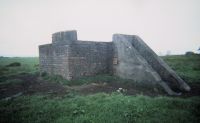 |
N.B:
Most of the images on this page are links to larger images of the minature shown.
A word about the photograph above right. It is NOT in Cumbria, but is of one of the Glasgow "SF" (Starfish) sites, which I photographed in 1984. I just thought it might be of interest, as it shows a different type of control shelter; that of Air-Ministry pattern CTD 557/41. From recollection, its location corresponds with the site of the Civil "SF" site at Parknewk, NGR NS664533 (55.7546N, -4.1303W) near East Kilbride.
A national decoy authority headed by Colonel John Fisher Turner was set up in July 1940, and following earlier experiments in Glasgow and Sheffield, a system of urban lighting decoys was set up similar to those used for military installations. These urban decoys were to be known as "Civil" sites; Civil QL for urban lighting simulation, and Civil QF for dummy fires. "Q" - sites (which took their title from the Royal Navy's use of "Q" - ships; warships disguised as merchant vessels) were equipped with assorted electrical and pyrotechnical apparatus to simulate the flare given from furnace doors, steel-making, railway marshalling yards, and light given off by inefficient blackout precautions.
Other sites simulated small fires started by incendiary bombs, with oil-storage area fire simulation being developed at Greystoke castle, near Penrith (The oil-storage area bombing decoys were designed to be operated by the Petroleum Authority, and were not as successful as the other types of decoy site, for a variety of reasons - notably disagreement over staffing.). A further variation on fire decoy sites was the "SF", or "Special Fires" sites. A larger, longer-burning type of fire was provided at these sites - known as "Starfish" sites - to draw incendiary bombs, and hopefully as a consequence the full enemy payload, from falling on the larger conurbations and defence installations during the blitz.
Ultimately, the civil decoy sites were staffed largely by civilian personnel from the works they were covering for. This was not always the case, though, and some sites were staffed by such diverse bodies as the police, the RAF Barrage Balloon Detachment, anti-aircraft ops. rooms, and the Civil Defence department. Navy and Army decoys were staffed by sailors and soldiers, and the RAF decoys were staffed by selected RAF ground-crew.
 Typical decoy control bunker hidden behind its earthen revetment. A large blast-wall protects the entrance lobby, which gives onto two rooms. The room on the left of the lobby was the generator room, the generators being driven by Morris Cowley engines!
Typical decoy control bunker hidden behind its earthen revetment. A large blast-wall protects the entrance lobby, which gives onto two rooms. The room on the left of the lobby was the generator room, the generators being driven by Morris Cowley engines!
The room on the right of the lobby was the control room, where all the switchgear was installed to operate suitable fires or lights. There is an escape/observation hatch in the roof. There would also have been a couple of benches here, a telephone for issuing the instruction to switch on, and probably a small stove.
The decoy site was staffed - remembers Ethel Fisher M.B.E, whose family farmed the land on which the decoy site was constructed - mostly by disabled ex-servicemen who lived in their own homes in the Workington area. They had bus passes and travelled to St. Helens (where the control bunker was located) daily. There were eight staff altogether, and the decoy site was never unmanned.
BELOW:
Inside the control bunker, showing L to R: Looking in down the entrance lobby; The escape/
observation hatch in the control room; Looking out of the lobby, toward the blast wall.
The decoy site at Siddick took the form of a mock factory, and would probably have been used to draw bombs from either Chapel Bank, where special quality steel bearings were manufactured, Moss-bay, or possibly the dock. It was constructed in the field adjacent to the Eastman chemical factory (Ectona) by building contractor Eddie Harrison and his men, of Seaton, near Workington, and took the form of several "buildings" manufactured from wood and covered in tarpaulin sheets. There was very little brickwork used in construction.
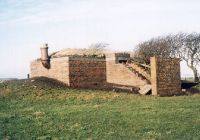 This site, which stands on Moresby Moss, was used to simulate "permitted lighting" given off by the Moss Bay Ironworks and Bessemer Converter five miles north of here. Permitted lighting was that which could not successfully be blacked out during air-raids, such as sparks from furnaces, coke-ovens, and loco firebox doors, etc. Banks of red and yellow lamps suspended from a canopy would cast their light onto trays of sand beneath, the whole operation being supplied via a rheostat in the control bunker. The brightness of the lamps would then be suitably adjusted to correspond to the variations in light observed when a real firebox door - for example - was opened.
This site, which stands on Moresby Moss, was used to simulate "permitted lighting" given off by the Moss Bay Ironworks and Bessemer Converter five miles north of here. Permitted lighting was that which could not successfully be blacked out during air-raids, such as sparks from furnaces, coke-ovens, and loco firebox doors, etc. Banks of red and yellow lamps suspended from a canopy would cast their light onto trays of sand beneath, the whole operation being supplied via a rheostat in the control bunker. The brightness of the lamps would then be suitably adjusted to correspond to the variations in light observed when a real firebox door - for example - was opened.
The stepped walls next to the entrance follow the profile of the earth revetment, which originally would have been banked up to roof level. The exhaust duct from the generator room and the cable duct just left of the entrance can clearly be seen.
As with the Siddick site, click on a minature image below to view a larger one. Use your "BACK" button to navigate.
This bunker is in good condition, and is currently used as a kind of agricultural repository. The construction and orientation is identical to the site at Siddick.
BELOW:
Inside the control bunker. Control room on the left, generator room on the right.
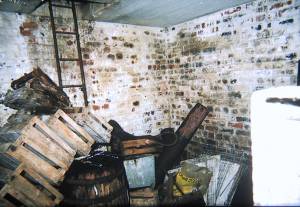 |
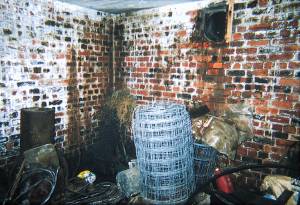 |
Simon Ledingham sent the following aerial shots of the decoy generator / watch-office building, which still appears to be in good condition. Even the ceramic exhaust-pipe remains intact.
I would like to extend thanks to Glynn Griffith, who alerted me to decoys around the Barrow and Millom area, and to Dave Parkin for information, photographs and notes regarding these sites. Both these fellow decoyologists work tirelessly for the Millom RAF Museum. These sites, dotted around Barrow-In-Furness, were Naval ("N"-series) QL/STARFISH sites, rather than civil ("C"-series) decoys. The upper photographs are of the "QL" control and generator shelters.
The lower centre photograph is of the "SF" control bunker at Wylock Marsh on Walney Island. This bunker would be used as a control point to ignite the special fires, and no electrical generator was needed. The decoy site was shared with the "QL" site shown in the other pictures. Interestingly, the 'QL' decoy bunker is equipped with a loop-hole, suggesting that it was defended.
There were two further Naval decoy sites in Cumberland: At land adjoining the old Alice pit, between Great Broughton and Dearham. This was referred to locally as the "Dummy Dump", and was decoy site to the Royal naval Armaments Depot at Broughton Moor. The Admiralty was generous enough to provide air-raid shelters to farmers whose property bordered this particular site!
 This site was one of two constructed to draw the enemy away from the munitions works at Eskmeals and Hycemoor, on the cumbrian coast.
This site was one of two constructed to draw the enemy away from the munitions works at Eskmeals and Hycemoor, on the cumbrian coast.
The site at Scaleby was a night ("Q") decoy for Crosby-on-Eden aerodrome, near Carlisle. It is of the "Drem" pattern (type 367/41) and official records indicate that it was operational in August 1942. It was manned by two airmen at a time from the parent station, with operational requirements being issued via field-telephone from a nearby wireless station.
The wireless station was built in the style of a bungalow, complete with substantial air-raid shelter adjacent. This wireless station - part of the decoy set-up - is now a fully functional and occupied.... bungalow!
THE CONTROL BUNKER.
By clicking on the image links below, you can see inside the control bunker. Still in good condition and pretty dry is the main part of the shelter, which would have housed the control switches and a stove. Beyond that is a small generator room, where close inspection shows the two engine beds which are still there. The generator end is constructed from pre-fabricated concrete sections, rather like a "Stanton" air-raid shelter. An entrance lobby seperates the generator room from the control room. The blast-wall across the entrance lobby has been demolished.
The RH photograph show the building viewed from the generator end, and the expansion chambers can be seen at ground level. These damped the noise of the engines.
THE WIRELESS STATION AIR-RAID SHELTER.
All the earth blast-protection has long since been trampled away, some - no doubt - forced away by the roots of the now substantial tree which is fixed there!
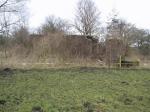 The concrete platform above the entrance to the mid-RH side of this photograph is where a moveable car headlamp was mounted, and would be slowly swung in an arc to give the appearance (from the air) of a taxiing aircraft. The low platform at the extreme RH side beyond the blast-wall is a coal-bunker for the stove. The decoy site was located where it is to attract enemy aircraft as they flew towards Crosby-On-Eden from the west, using the river Eden to navigate.
The concrete platform above the entrance to the mid-RH side of this photograph is where a moveable car headlamp was mounted, and would be slowly swung in an arc to give the appearance (from the air) of a taxiing aircraft. The low platform at the extreme RH side beyond the blast-wall is a coal-bunker for the stove. The decoy site was located where it is to attract enemy aircraft as they flew towards Crosby-On-Eden from the west, using the river Eden to navigate.
PHOTOGRAPHS: Dave Parkin, Heysham.
One of two 'DREM' Q- decoys for Silloth aerodrome (both of which were located south of Silloth), the Edderside decoy shown here survives in pretty good condition. The other decoy site was at Pelutho, and has long since been demolished. Identical in every respect to the Scaleby decoy (above), the swivel headlamp platform and 'Stanton' generator attachment can clearly be seen.
The pictures below give an insight into bunker construction, as most of the earth has been eroded leaving the tin-sheeting shell exposed. The lower-right picture shows the concrete slab directly above the front entrance where the swivel-headlight was located.
Home | Contents | Workington | Links | E-Mail